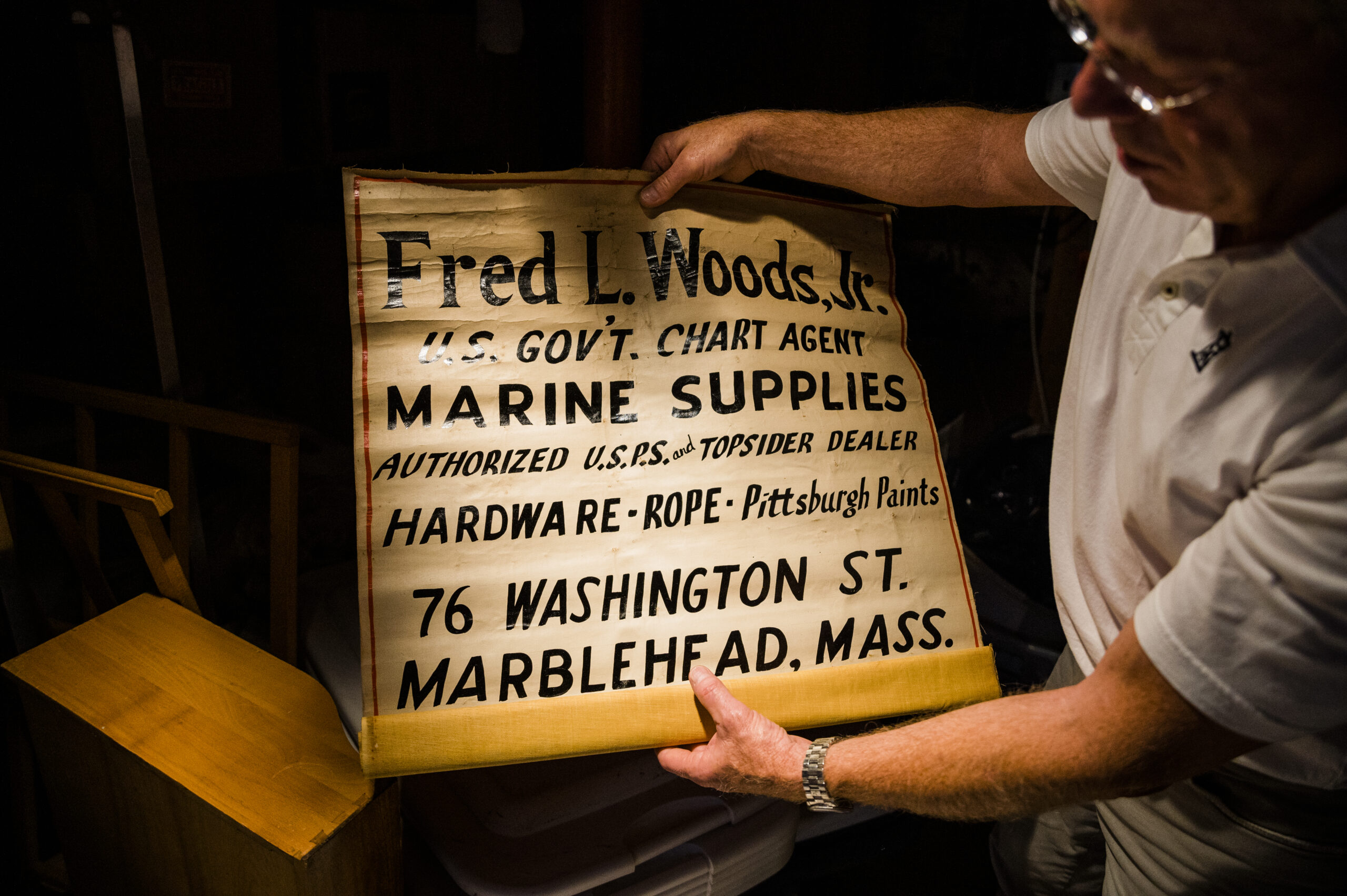F. L. Woods wasn’t always in the clothing business. The oldest continuously operating store in town traces its roots back to 1935, and is deeply intertwined with Marblehead’s history as a maritime destination.
When Fred L. Woods Jr. opened the store, it quickly became a destination for mariners after he was awarded the first U.S. Government Chart agency in 1939. Woods sold nautical charts, tide tables, sextants, compasses, and even designed private signals, or burgees, for anyone who asked.
“Basically everything you needed to go to sea” was sold at the store, owner Wayne B. George explained in an interview inside the original location on Washington Street.
“You couldn’t go to sea without Fred Woods,” George said.
Woods’ family owned The Boston Herald and lived in Brookline, spending summers in Marblehead. He moved to the town full-time after meeting his wife Nathalie Frost Hawks Woods, a local.
“He was the summer kid that married the townie girl,” George said.
Nathalie Woods was then left in charge of the store after her husband’s passing. She didn’t know what to do with it, and decided to close it. But, after demand from local fishermen, she reopened the doors to F.L. Woods. In doing so, she reapplied to become a U.S. Government Chart agent, becoming the first woman to take on the role.
“What’s unique about this place is over all these years it’s become a Marblehead institution, and sort of a Marblehead tradition,” says George, who has owned the store for 20 years. “We’ve all grown up getting Christmas presents or birthday presents or gifts from here, as well as nautical things you might need to go to sea.”
Under George’s stewardship, the focus of the business has shifted to clothing. Inside the store, hats, shirts, shorts, jackets, and more are all for sale. Most, if not all, bear the iconic buoy logo on the sign hanging outside the store.
The buoy, George says, was first designed by Nathalie Woods when the Washington Street location opened in 1938. In the ensuing years, it has served as the store’s mascot.
“The buoy just took on a life of its own and I think what people love about it is that it does represent something that’s so authentic,” he explains. “It has real pedigree, it’s not a made-up nautical brand.”
George came to F. L. Woods organically.
Before buying the store, he ran a worldwide marketing group for a software company, living on planes and traveling constantly. The opportunity to buy F. L. Woods came about when he “bumped into” descendants of Fred and Nathalie Woods, who told him the store was constantly closed because no one in the family could run it.
Buyers were interested in purchasing the building, George said, but none had an interest in the store’s history. As a yachting-history buff, he couldn’t pass up the opportunity to preserve decades of history. So, the recently-retired George stopped by the Woods family’s home on Gas House Beach and, over a cup of coffee, bought the building and the business on a handshake.
“It wasn’t for sale, no realtors, no contracts, just on a handshake. And honestly, until the day that it closed, when the money changed hands, I didn’t really know if it was happening or if it wasn’t happening. I know a handshake meant something in the old days. But nowadays, handshakes are marginal at best,” he said with a chuckle. “But lo and behold, the closing date came and everybody showed up and all of a sudden, my wife said, ‘What are you doing?’ And I said, ‘I guess I’m going into retail.’”
“It really was just out of my passion for nautical history that I wanted to be sure that this place would carry on,” he added.
The transition from selling nautical charts to clothing came about because “the industry was in transition,” George said.
“People had transitioned from buying charts to go to sea, to buying charts to wallpaper their bathrooms. And now all of these charts are on your phone, your GPS is on your phone, you can run charting software on your phone, boats all have integrated GPS systems, and there was no demand for compasses and sextants,” he said. “Fred sold a lot of nautical books, and so that stuff just didn’t really have much of a future.”
But, Fred Woods did begin selling wool sweaters and boat shoes in his later years.
“You could come in and get a chart and you could get a yellow slicker, you get a wool sweater, and you get some boat shoes,” he explains. “It just seemed so natural to me that that was the place to transition the business to and really try and build an authentic nautical lifestyle brand.”
Each piece of clothing for sale in the store has been designed by George, who said he agonizes over small details on every item. The first thing he designed was a pair of shorts in “Marblehead green,” an old yacht paint manufactured in the town.
The paint has a fascinating story of its own.
A unique sagey-green color, the paint came about as a way for sailors to gain an advantage over their competitors in races, by inventing a way to keep barnacles and borers off of their boats. And so, Marblehead green came to be one of the first anti-fouling paints.
The paint was manufactured in Marblehead and sold at F. L. Woods long before George took over the store. It became a success rapidly, not just because it succeeded in the initial mission of protecting the bottoms of boats, but because of its color.
“Because it was this bright sage green, it would glow underwater, so you could see the shape of your hull under the water. And of course, that was of a lot of interest to the yacht designers at the time because it would really show off their hull forms,” George explained.
He noted that the paint was also endorsed by a number of naval architects, including John Alden and W. Starling Burgess, during the time it was for sale.
George said the paint was often sold with the tagline, “the most powerful preventative: marine growth barnacles and borers.”
The unique green color came about by accident, George said, due to the presence of powdered lead in the formulation, which would react with the other chemicals in the paint to create the sage green.
“And so nothing dared grow on the bottom of a boat with Marblehead green paint, because it was laced with powdered lead,” he says.
Eventually, in the mid-1950s, the paint was discontinued due to its toxicity.
While George has worked to transition F.L. Woods into the 21st century, recently launching a website, many of the historic touches remain — including the creaky wood floors and a decades-old computer used to ring up sales.
In the store’s basement, George stores artifacts dating back decades, including a hand-painted sign advertising the products Fred Woods used to sell, which George suspected was taken to the Halifax race.
Also in the basement live two Macintosh SE/30 computers that George said functioned until the day he unplugged them.
Sewn inside the Woods Mariners Jacket, which George designed to commemorate the 75th anniversary of the store, is a quote from Fred Woods that was printed on the flyers he used to hand out to customers who he designed private signals for, instructing them how to fly them on their boats.
The quote? “May your colors fly freely and proudly for a long time.”

